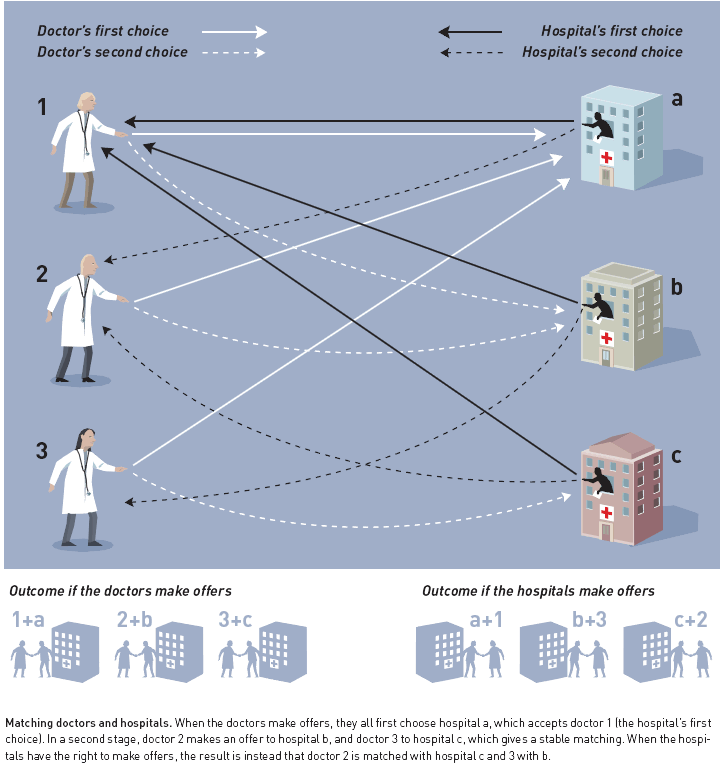|
News & Views item - October 2012 |
![]() The 2012 Nobel Prize in Economic Sciences is Announced. (October 16, 2012)
The 2012 Nobel Prize in Economic Sciences is Announced. (October 16, 2012)
The Royal Swedish Academy of Sciences has decided to award The Sveriges Riksbank
Prize in Economic Sciences in Memory of Alfred Nobel for 2012 to Alvin E. Roth
Harvard University and Harvard Business School, and Lloyd S. Shapley University
of California, Los Angeles for the theory of stable allocations and the
practice of market design.
The Swedish Academy's press release reads:
 This
year's Prize concerns a central economic problem: how to match different agents
as well as possible. For example, students have to be matched with schools, and
donors of human organs with patients in need of a transplant. How can such
matching be accomplished as efficiently as possible? What methods are beneficial
to what groups? The prize rewards two scholars who have answered these questions
on a journey from abstract theory on stable allocations to practical design of
market institutions.
This
year's Prize concerns a central economic problem: how to match different agents
as well as possible. For example, students have to be matched with schools, and
donors of human organs with patients in need of a transplant. How can such
matching be accomplished as efficiently as possible? What methods are beneficial
to what groups? The prize rewards two scholars who have answered these questions
on a journey from abstract theory on stable allocations to practical design of
market institutions.
Lloyd Shapley used so-called cooperative game theory to study and compare different matching methods. A key issue is to ensure that a matching is stable in the sense that two agents cannot be found who would prefer each other over their current counterparts. Shapley and his colleagues derived specific methods – in particular, the so-called Gale-Shapley algorithm – that always ensure a stable matching. These methods also limit agents' motives for manipulating the matching process. Shapley was able to show how the specific design of a method may systematically benefit one or the other side of the market.
Alvin Roth recognized that Shapley's theoretical results could clarify the functioning of important markets in practice. In a series of empirical studies, Roth and his colleagues demonstrated that stability is the key to understanding the success of particular market institutions. Roth was later able to substantiate this conclusion in systematic laboratory experiments. He also helped redesign existing institutions for matching new doctors with hospitals, students with schools, and organ donors with patients. These reforms are all based on the Gale-Shapley algorithm, along with modifications that take into account specific circumstances and ethical restrictions, such as the preclusion of side payments.
Even though these two researchers worked independently of one another, the combination of Shapley's basic theory and Roth's empirical investigations, experiments and practical design has generated a flourishing field of research and improved the performance of many markets. This year's prize is awarded for an outstanding example of economic engineering.

Yudhijit Bhattacharjee writing for ScienceNow quotes this example in explaining the work:
Trade between a group of rational actors, Shapley reasoned, would reach a stable state if no individual had anything further to gain by making a new trade. Along with an economist and mathematician named David Gale, Shapley applied this idea of stability to the case of marriages, setting up an example of pairing 10 women and 10 men into couples.
The two came up with a matchmaking method called the "deferred acceptance"
algorithm, which could proceed in either of two ways. In one scenario, the men
propose to the women, and each woman rejects the men she finds unsuitable while
holding on to—but not yet accepting—the proposal she likes best. In the next
round, the rejected men propose to their second-best choice, and the women again
retain or choose what they view as the best offer while rejecting the rest. Over
several rounds, the pairings become stable.
In an alternate scenario, the women propose to the men. This leads to a
different set of pairings. Although stable matching emerges as an outcome in
both scenarios, Gale and Shapley showed that the matching is more favorable to
women when the women propose and vice versa. Gale died in 2008.
The Nobel website also makes the following additional information available:
Information for the Public: Stable matching: Theory, evidence, and
practical design![]()
Scientific Background: Stable allocations and the practice of market
design![]()